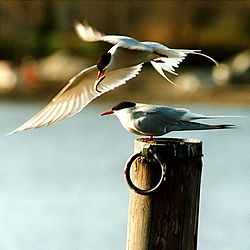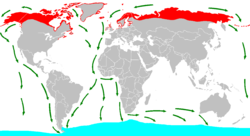Arctic Tern
Facts
Conservation Status: Least Concern
Location: Arctic and sub-Arctic regions of Europe, Asia, and North America (as far south as Brittany and Massachusetts)
Lifespan: 20 years
Conservation Status: Least Concern
Location: Arctic and sub-Arctic regions of Europe, Asia, and North America (as far south as Brittany and Massachusetts)
Lifespan: 20 years
Scientific Classification
Kingdom: Animalia
Phylum: Chordata
Class: Aves
Order: Charadriiformes
Family: Sternidae
Genus: Sterna
Species: S. paradisaea
Binomial name: Sterna Paradisaea
Description
Length: 33 to 39 cm (13 to 15 in)
Wingspan: 76 to 85 cm (26 to 35 in)
Flying Distance: 70,900 km (44,300 miles) each year
Other: The adult plumage is grey above, with a black nape and crown and white cheeks. The upperwings are pale grey, with the area near the wingtip being translucent. The tail is white, and the underparts pale grey. Both sexes are similar in appearance. The winter plumage is similar, but the crown is whiter and the bills are darker.
Length: 33 to 39 cm (13 to 15 in)
Wingspan: 76 to 85 cm (26 to 35 in)
Flying Distance: 70,900 km (44,300 miles) each year
Other: The adult plumage is grey above, with a black nape and crown and white cheeks. The upperwings are pale grey, with the area near the wingtip being translucent. The tail is white, and the underparts pale grey. Both sexes are similar in appearance. The winter plumage is similar, but the crown is whiter and the bills are darker.
Behaviour
The species has a variety of calls; the two most common being the alarm call, made when possible predators (such as humans or other mammals) enter the colonies, and the advertising call. The advertising call is social in nature, made when returning to the colony and during aggressive encounters between individuals. It is unique to each individual tern and as such it serves a similar role to the bird song of passerines, identifying individuals. Eight other calls have been described, from begging calls made by females during mating to attack calls made while swooping at intruders. Arctic Terns sometimes dip down to the surface of the water to catch prey close to the surface. They may also chase insects in the air when breeding. It is also thought that Arctic Terns may, in spite of their small size, occasionally engage in Kleptoparasitism by swooping at birds so as to startle them into releasing their catches. Several species are targeted—conspecifics, other terns (like the Common Tern), and some auk and grebe species. While nesting, Arctic Terns are vulnerable to predation by cats and other animals. Besides being a competitor for nesting sites, the larger Herring Gull steals eggs and hatchlings. Camouflaged eggs help prevent this, as do isolated nesting sites. While feeding, skuas, gulls, and other tern species will often harass the birds and steal their food. They often form mixed colonies with other terns, such as Common and Sandwich Terns.
The species has a variety of calls; the two most common being the alarm call, made when possible predators (such as humans or other mammals) enter the colonies, and the advertising call. The advertising call is social in nature, made when returning to the colony and during aggressive encounters between individuals. It is unique to each individual tern and as such it serves a similar role to the bird song of passerines, identifying individuals. Eight other calls have been described, from begging calls made by females during mating to attack calls made while swooping at intruders. Arctic Terns sometimes dip down to the surface of the water to catch prey close to the surface. They may also chase insects in the air when breeding. It is also thought that Arctic Terns may, in spite of their small size, occasionally engage in Kleptoparasitism by swooping at birds so as to startle them into releasing their catches. Several species are targeted—conspecifics, other terns (like the Common Tern), and some auk and grebe species. While nesting, Arctic Terns are vulnerable to predation by cats and other animals. Besides being a competitor for nesting sites, the larger Herring Gull steals eggs and hatchlings. Camouflaged eggs help prevent this, as do isolated nesting sites. While feeding, skuas, gulls, and other tern species will often harass the birds and steal their food. They often form mixed colonies with other terns, such as Common and Sandwich Terns.
Predators or Prey?
Arctic Tern nests are vulnerable to predation on eggs and young by foxes, skunks, dogs, cats, and avian predators. Adults generally escape ground predators but may be taken by owls or raptors; jaegers and gulls also prey on eggs and young and harass adults. The Arctic Terns prey are fish or marine crustaceans.
Arctic Tern nests are vulnerable to predation on eggs and young by foxes, skunks, dogs, cats, and avian predators. Adults generally escape ground predators but may be taken by owls or raptors; jaegers and gulls also prey on eggs and young and harass adults. The Arctic Terns prey are fish or marine crustaceans.
Diet
The diet of the Arctic Tern varies depending on location and time, but is usually carnivorous. In most cases, it eats small fish or marine crustaceans. Fish species comprise the most important part of the diet, and account for more of the biomass consumed than any other food. Prey species are immature (1–2 year old) shoaling species such as herring, cod, sandlances, and capelin. Among the marine crustaceans eaten are amphipods, crabs and krill. Sometimes, these birds also eat molluscs, marine worms, or berries, and on their northern breeding grounds, insects.
The diet of the Arctic Tern varies depending on location and time, but is usually carnivorous. In most cases, it eats small fish or marine crustaceans. Fish species comprise the most important part of the diet, and account for more of the biomass consumed than any other food. Prey species are immature (1–2 year old) shoaling species such as herring, cod, sandlances, and capelin. Among the marine crustaceans eaten are amphipods, crabs and krill. Sometimes, these birds also eat molluscs, marine worms, or berries, and on their northern breeding grounds, insects.
Habitat
The Arctic Tern breeds in open tundra, boreal forest, or on rocky islands and beaches. Migrates far off shore. Winters on edge of pack ice.
The Arctic Tern breeds in open tundra, boreal forest, or on rocky islands and beaches. Migrates far off shore. Winters on edge of pack ice.
Conservation
Arctic Terns are considered threatened or species of concern in certain states. They are also among the species to which the Agreement on the Conservation of African-Eurasian Migratory Waterbirds applies. The species declined in New England in the late nineteenth-century due to hunting for the millinery trade. Exploitation continues today in western Greenland, where the species has declined greatly since 1950.
At the southern part of their range, the Arctic Tern has been declining in numbers. Much of this is due to shortages of food. However, most of these birds' range is extremely remote, with no apparent trend in the species as a whole.
Birdlife International has considered the species to be at lower risk since 1988, believing that there are approximately one million individuals around the world.
Arctic Terns are considered threatened or species of concern in certain states. They are also among the species to which the Agreement on the Conservation of African-Eurasian Migratory Waterbirds applies. The species declined in New England in the late nineteenth-century due to hunting for the millinery trade. Exploitation continues today in western Greenland, where the species has declined greatly since 1950.
At the southern part of their range, the Arctic Tern has been declining in numbers. Much of this is due to shortages of food. However, most of these birds' range is extremely remote, with no apparent trend in the species as a whole.
Birdlife International has considered the species to be at lower risk since 1988, believing that there are approximately one million individuals around the world.
Reproduction
Breeding begins around the third or fourth year. Arctic Terns mate for life, and in most cases, return to the same colony each year. Courtship is elaborate, especially in birds nesting for the first time. Courtship begins with a so-called "high flight", where a female will chase the male to a high altitude and then slowly descend. This display is followed by "fish flights", where the male will offer fish to the female. Courtship on the ground involves strutting with a raised tail and lowered wings. After this, both birds will usually fly and circle each other. Both sexes agree on a site for a nest, and both will defend the site. During this time, the male continues to feed the female. Mating occurs shortly after this. Breeding takes place in colonies on coasts, islands and occasionally inland on tundra near water. It often forms mixed flocks with the Common Tern. It lays from one to three eggs per clutch, most often two. The nest is usually a depression in the ground, which may or may not be lined with bits of grass or similar materials. The eggs are mottled and camouflaged. Both sexes share incubation duties. The young hatch after 22–27 days and fledge after 21–24 days. If the parents are disturbed and flush from the nest frequently the incubation period could be extended to as long as 34 days.
Breeding begins around the third or fourth year. Arctic Terns mate for life, and in most cases, return to the same colony each year. Courtship is elaborate, especially in birds nesting for the first time. Courtship begins with a so-called "high flight", where a female will chase the male to a high altitude and then slowly descend. This display is followed by "fish flights", where the male will offer fish to the female. Courtship on the ground involves strutting with a raised tail and lowered wings. After this, both birds will usually fly and circle each other. Both sexes agree on a site for a nest, and both will defend the site. During this time, the male continues to feed the female. Mating occurs shortly after this. Breeding takes place in colonies on coasts, islands and occasionally inland on tundra near water. It often forms mixed flocks with the Common Tern. It lays from one to three eggs per clutch, most often two. The nest is usually a depression in the ground, which may or may not be lined with bits of grass or similar materials. The eggs are mottled and camouflaged. Both sexes share incubation duties. The young hatch after 22–27 days and fledge after 21–24 days. If the parents are disturbed and flush from the nest frequently the incubation period could be extended to as long as 34 days.



